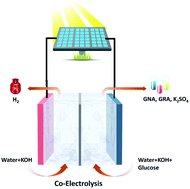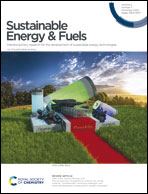Techno-economic analysis of a solar-powered biomass electrolysis pathway for coproduction of hydrogen and value-added chemicals†
Abstract
Electrochemical oxidation of biomass to fuels and value-added chemicals represents an emerging strategy for storing renewable energy and achieving a higher grade of sustainability in chemical industries. While research is still in its infancy, it is important to analyse the economic feasibility of such a process. In this study, we present a detailed techno-economic analysis (TEA) of a potential photo-biorefinery approach for sunlight-driven electro-oxidation of glucose to produce valuable fuels and chemicals i.e., H2, gluconic acid (GNA) and glucaric acid (GRA). Under a base case scenario, the results are promising with a minimum selling price (MSP) of GRA at $6.94 per kg, which will be ∼70% lower than the current market price. The detailed breakdown and sensitivity analysis suggest that unlike conventional water electrolysis, the cost of raw materials and separation has a significant impact on the economics. Furthermore, we also establish performance targets for conversion (90%), selectivity (90%), feed concentration (0.5 M) and operating current density (0.4 A cm−2) such that if these targets are achieved, photo-electrochemical conversion of biomass to fuels and chemicals can become a very profitable option with a MSP of GRA as low as $1.42 per kg.



 Please wait while we load your content...
Please wait while we load your content...